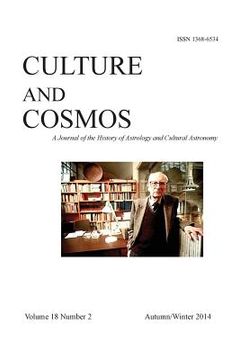Synopsis "Culture and Cosmos: Vol 18 number 2 (in English)"
This issue of Culture and Cosmos includes seven significant papers on the history of astrology, covering a range of periods and approaches. Roger Beck's 'The Ancient Mithraeum as a Model Universe. Part 2', touches on archaeoastronomy and classical religion [1]. Helena Avelar and Charles Burnett's analysis of a twelfth century horoscope cast by Abraham the Jew examines the technical practice of medieval astrology. Lindsay Starkey's paper on Mellin de Saint-Gelais and John Calvin, and Scott Hendrix's on Galileo, concern theoretical contexts for the European astrology of the middle ages and Renaissance. Richard Angelo Bergen's 'Paradise Lost and the Descent of Urania: from Astrology to Allegory' deals with literature, Hakan Kirkoğlu's 'Ilm-i nudjum and 18th century Ottoman Court Politics' examines the political uses of astrology, and Graham Douglas's 'Trystes Cosmologiques: When Lévi-Strauss Met the Astrologers' explores one of the twentieth century's most important anthropologist's attitudes to astrology [2]. Anything Lévi-Strauss said about astrology is of interest by definition, in view of his authorship of a remarkable series of seminal works (The Elementary Structures of Kinship (1949), Tristes tropiques (1955), Structural Anthropology (1961), Mythologiques (1964), The Raw and the Cooked (1964), and The Savage Mind (1966). Lévi-Strauss, coming last chronologically in this journal, also has the last word. In response to a question about the surrealist André Breton, Lévi-Strauss replied: I knew André Bréton well - we were very close for a period of time; but I won't go as far as him. I wouldn't say that it holds [secrets] - but it is perhaps one of the signs that secrets exist which we don't understand, and I feel impelled to say, that we will doubtless never understand. It is precisely this lack of understanding which motivates historians: with just a little more evidence, we hope, perhaps we will understand the world a little better. And perhaps, then, the papers in this issue will take us a little closer to understanding astrology's appeal, claims, role, nature, function, ideology, world-view and cultural significance. Dr Nicholas Campion, University of Wales Trinity Saint David [1] Part 1 was published as Roger Beck, 'The Ancient Mithraeum as a Model Universe. Part 1', in Heavenly Discourses, ed. Nicholas Campion (Lampeter: Sophia Centre Press, 2016), pp. 21-31. [2] For comparison see Nicholas Campion, 'Surrealist Cosmology: André Breton and Astrology', Culture and Cosmos 6, no. 2 (Autumn/Winter 2002): pp. 45-56.

